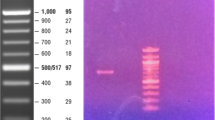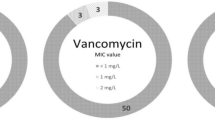Abstract
We report an outbreak of linezolid-resistant Staphylococcus haemolyticus strains (MIC 32 mg/L) in patients admitted to the Verona University Hospital Intensive Care Unit. The strains proved to be clonally related at pulsed field gel electrophoresis. All the strains showed the G2576T mutation responsible for linezolid-resistance and retained their resistance even after several passages on antibiotic-free medium. After a decade of linezolid use, multifocal emergence of linezolid resistance in coagulase-negative staphylococci has become an important matter of concern and mandates stricter control over the use of this antibiotic in order to preserve its clinical utility.

Similar content being viewed by others
References
Farrell DJ, Mendes RE, Ross J, Jones RN (2009) Linezolid surveillance program results for 2008 (LEADER Program for 2008). Diagn Microbiol Infect Dis 65:392–403
Rossolini GM, Mantengoli E, Montagnani F, Pollini S (2010) Epidemiology and clinical relevance of microbial resistance determinants versus anti-Gram-positive agents. Curr Opin Microbiol 13:582–588
Kelly S, Collins J, Davin M, Gowing C, Murphy PG (2006) Linezolid resistance in coagulase-negative staphylococci. J Antimicrob Chemother 58:898–899
Bongiorno D, Campanile F, Mangelli G, Baldi MT, Provenzani R, Reali S, Lo Russo C, Santagati M, Stefani S (2010) DNA methylase modifications and other linezolid resistance mutations in coagulase-negative staphylococci in Italy. J Antimicrob Chemother 65:2236–2240
Rodriguez-Aranda A, Daskalaki M, Villar J, Sanz F, Otero JR, Chaves F (2009) Nosocomial spread of linezolid-resistant Staphylococcus haemolyticus infections in an intensive care unit. Diagn Microbiol Infect Dis 63:398–402
Bozdogan B, Appelbaum PC (2004) Oxazolidinones: activity, mode of action, and mechanism of resistance. Int J Antimicrob Agents 23:113–119
Tsiodras S, Gold SH, Saloulas G, Eliopoulos GM, Wennerste C, Venkataraman L, Moellering RC, Ferraro MJ (2001) Linezolid resistance in a clinical isolate of Staphylococcus aureus. Lancet 358:207–208
Marshall SH, Donskey CJ, Hutton-Thomas R, Salata RA, Rice LB (2002) Gene dosage and linezolid resistance in Enterococcus faecium and Enterococcus faecalis. Antimicrob Agents Chemother 46:3334–3336
Meka VG, Pillai SK, Sakoulas G, Wennersten C, Venkataraman L, De Girolami PC, Eliopoulos GM, Moellering RC, Gold HS (2004) Linezolid resistance in sequential Staphylococcus aureus isolates associated with a T2500A mutation in the 23S rRNA gene and loss of a single copy of rRNA. J Infect Dis 190:311–317
Wong A, Reddy SP, Smyth DS, Aguero-Rosenfeld ME, Sakoulas G, Robinson DA (2010) Polyphyletic emergence of linezolid-resistant staphylococci in the United States. Antimicrob Agents Chemother 54:742–748
Bonora MG, Solbiati M, Stepan E, Zorzi A, Luzzani A, Catania MR, Fontana R (2006) Emergence of linezolid resistance in the vancomycin-resistant Enterococcus faecium multi locus sequence typing C1 epidemic lineage. J Clin Microbiol 44:1153–1155
Wolter N, Smith AM, Farrell SJ, Schaffner W, Moore M, Whitney CG, Jorgensen JH, Klugman KP (2005) Novel mechanism of resistance to oxazolidinones, macrolides, and chloramphenicol in ribosomal protein L4 of the Pneumococcus. Antimicrob Agents Chemother 49:3554–3557
Seok-Ming T, Xiong L, Arias CA, Villegas MV, Lolans K, Quinn J, Mankin AS (2007) Acquisition of a natural resistance gene renders a clinical strain of methicillin-resistant Staphylococcus aureus resistant to the synthetic antibiotic linezolid. Mol Microbiol 64:1506–1514
Mendes RE, Deshpande L, Rodriguez-Noriega E, Ross JE, Jones RN, Morfin-Otero R (2010) First report of staphylococcal clinical isolates in Mexico with linezolid resistance cause by cfr evidence of in vivo cfr mobilitation. J Clin Microbiol 48:3041–3043
The European Committee on Antimicrobial Susceptibility Testing (2011) Clinical breakpoints, version 1.1. Available at: http://www.eucast.org/clinical_breakpoints/. Accessed 19 July 2011
Shittu A, Lin J, Morrison D, Kolawole D (2006) Identification and molecular characterization of mannitol salt positive, coagulase-negative staphylococci from nasal samples of medical personnel and students. J Medic Microbiol 55:317–324
Kehrenberg C, Schwarz S (2006) Distribution of florfenicol resistance genes fexA and Cfr among chloramphenicol-resistant Staphylococcus isolates. Antimicrob Agents Chemother 50:1156–1163
Locke JB, Hilgers M, Shaw KJ (2009) Mutations in ribosomal protein L3 are associated with oxazolidinone resistance in staphylococci of clinical origin. Antimicrob Agents Chemother 53:5275–5278
Bannerman TL (2003) Staphylococcus, Micrococcus, and other catalase-positive cocci that grow aerobically. In: Murray PR, Baron EJ, Jorgensen JH, Pfaller MA, Yolken RH (eds) Manual of clinical microbiology, 8th edn. American Society for Microbiology, Washington, D.C.
Froggatt JW, Johnston JL, Galetto DW, Archer GL (1989) Antimicrobial resistance in nosocomial isolates of Staphylococcus haemolyticus. Antimicrob Agents Chemother 33:460–466
Takeuchi F, Watanabe S, Baba T, Yuzawa H, Ito T, Morimoto Y, Kuroda M, Cui L, Takahashi M, Ankai A, Baba S, Fukui S, Lee JC, Hiramatsu K (2005) Whole-genome sequencing of Staphylococcus haemolyticus uncovers the extreme plasticity of its genome and the evolution of human-colonizing staphylococcal species. J Bacteriol 187:7292–7308
Biavasco F, Vignaroli C, Varaldo PE (2000) Glycopeptide resistance in coagulase-negative staphylococci. Eur J Clin Microbiol Infect Dis 19:403–417
Author information
Authors and Affiliations
Corresponding author
Rights and permissions
About this article
Cite this article
Mazzariol, A., Lo Cascio, G., Kocsis, E. et al. Outbreak of linezolid-resistant Staphylococcus haemolyticus in an Italian intensive care unit. Eur J Clin Microbiol Infect Dis 31, 523–527 (2012). https://doi.org/10.1007/s10096-011-1343-6
Received:
Accepted:
Published:
Issue Date:
DOI: https://doi.org/10.1007/s10096-011-1343-6




